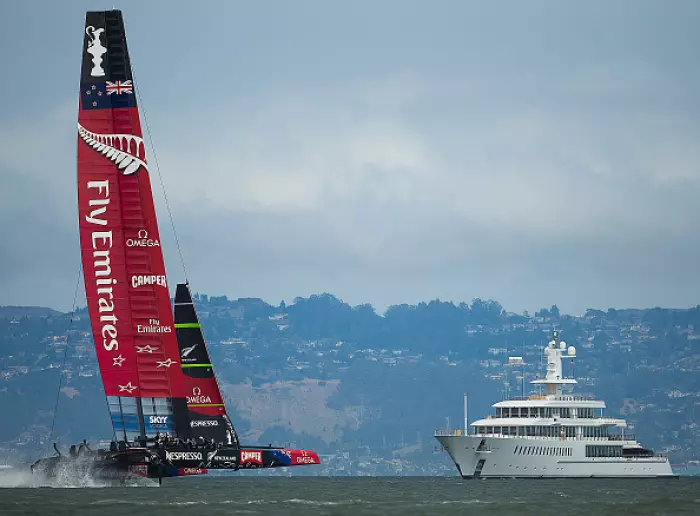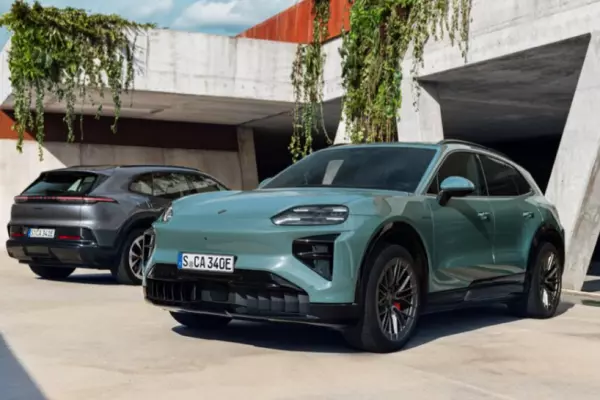Superyachts and the America’s Cup go together like supermodels and billionaires – in fact, the Venn diagram of those two pairings has a great deal of overlap.
Billionaires, even less-ostentatious ones, seem irresistibly drawn to superyachts and the Cup. When you have everything money can buy, you compete only with others like you.
Private jets are fun but they don’t make the same statement as a superyacht – almost always a ship rather than what Americans might call a sailboat but we’d call a yacht.
Mind you, I once saw a 747-8 private jet at Boeing in Seattle, apparently for Saudi businessman Prince Alwaleed bin Talal. Naturally, he also had a superyacht, Kingdom 5KR. Originally the Nabila, it was built for Saudi arms dealer Adnan Khashoggi before it went to the Sultan of Brunei and on to a New York real estate magnate called Donald Trump.
A sport for kings
There’s money in having this kind of craft visit Auckland for the 2021 America’s Cup and the challenger races this year – if only the superyacht crews and owners are allowed enter while the covid-19 restrictions are still in force.
Industry group NZ Marine estimates an average spend of $2.7 million for any boat over 24 metres (its definition of a superyacht), and more – perhaps $5 million to $10 million – for a refit or maintenance for sail and motor yachts capable of crossing oceans.
Of an estimated 7000 superyachts worldwide, perhaps 40 a year visit New Zealand. NZ Marine had hoped as many as 160 might come during the America’s Cup season before the coronavirus all but closed off that opportunity, though it has won permission for some crew to enter for repair or refit purposes, on application.
“A lot of the syndicates include people who are superyacht owners, and other owners are interested in the sport of sailing, and of course there are sponsors,” NZ Marine executive director Peter Busfield told BusinessDesk. He is desperate to get owners allowed in.
The rich are different
The new rich have been drawn to the America’s Cup since Australian larrikin and convict Alan Bond’s 1983 victory over the old-money brahmins of the New York Yacht Club, a period when newly minted fortunes coincided with a readiness to flash it in ways Sir Thomas Lipton never imagined, despite his Shamrock J-Class.
The 1987 America’s Cup in Fremantle brought with it flashy new entrants into the money-burning game, joining more traditional America’s Cup faces such as the Aga Khan.
A Japanese businessman, Masakazu Kobayashi (widely reported to be a billionaire, without evidence), arrived in Fremantle with what was then one of the biggest superyachts, Bengal 1, a 47.3-metre behemoth now called Triumphant Lady. Kobayashi’s plans to challenge for the Cup evaporated, as did his business, a curse of the America’s Cup that often befalls the rich who are drawn into it.
SuperYachtTimes.com says Triumphant Lady makes 14.5 knots powered by twin 1299-horsepower (969kW) Caterpillar engines. A crew of nine looks after 10 guests.
Art on board; diamond geezers
In 1982, French businessman-turned-politician Bernard Tapie bought what was then the largest sailing craft in the world, the four-mast racing yacht Club Méditerranée, made it even longer – extending it to 75 metres – and turned it into a floating palace, Phocéa.
While Dennis Conner, winner of the 1987 America’s Cup, sailed Phocéa off the Aga Khan’s yacht club in Sardinia, I had a tour inside, brushing the suede walls and noting a Magritte. See what I mean about the people who own, or say they own, this kind of boat?
David Richwhite and Michael Fay, who were then leading the New Zealand campaign, had a much less pretentious chartered motor yacht for the World 12-Metre Championships in Sardinia that same year, though it accommodated both their families and wasn’t small.
SuperYachtTimes.com says the Phocéa, now called Enigma and owned by Lebanese businesswoman Mouna Ayoub, is 75.13 metres long and tops 14 knots under sail or powered by its 1055-horsepower (787kW) MTU engine. Ayoub’s former husband is reported to have paid for its restoration partly from the sale of a single diamond, The Mouna. (Another woman with a big boat is Laurene Powell Jobs, widow of Steve Jobs, who has kept his Philippe Starck-designed 100 million-euro 78-metre Venus, which was under construction when he died in 2011.)
Art on yachts is a dilemma. All that salt air, humidity, insurance. British insurance industry magnate Joe Lewis is an even more serious art collector than he is a buyer of implausible motor yachts. His 98-metre-long Aviva hosts an art collection probably worth more than the yacht itself. A reporter noticed Francis Bacon’s Triptych1974-1977 on the lower deck. The painting was sold in 2008 for just under US$52 million.
SuperYachtTimes.com says Aviva gets a maximum speed of 20 knots from its twin 3916-horsepower (2920kW) MTU engines.
Camouflage that shouts “I’m rich!”
Art on the exterior of yachts is also a thing. Jeweller Michael Hill has a naval-looking 39-metre-long motor superyacht known as The Beast moored in Silo Marina in Auckland’s Wynyard Quarter. It features a marine camouflage paint job first deployed in World War I known as ‘Dazzle Ships’ or ‘razzle dazzle’.
A confused array of geometric shapes breaks up the visual structure of the Palmerston North-built catamaran, which looks as if it could as easily go to Antarctica as Waiheke and has its own game-fishing powerboat stored on top.
“I’d had it in mind to go for a slightly different vessel if I ever built again,” Hill told Boat magazine of The Beast, “because every time you have a boat, you always think of things that might be slightly better or different, and I just thought, ‘Wouldn’t it be great to have an expedition-style boat that could go anywhere, that was seriously stable?’”.
For nerds, SuperYachtTimes.com says The Beast tops out at 11 knots powered by its twin 1000-horsepower (746kW) Caterpillar engines.
While talking about New Zealanders with superyachts, it would be churlish not to mention former panel-beater-turned-US packaging magnate Graeme Hart’s 116-metre-long Ulysses, launched in Norway in 2018 and packed with toys to explore the depths of the oceans and irritate lesser superyacht owners. SuperYachtTimes.com says it has twin 2956-horsepower (2204kW) Caterpillars.
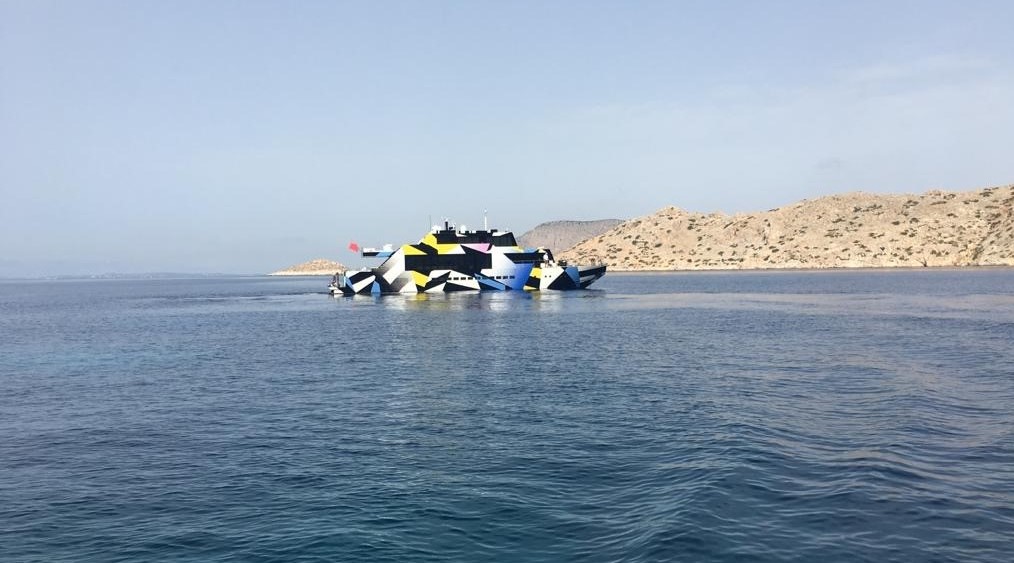 Superyacht Guilty, featuring 'razzle dazzle' paintwork by Jeff Koons, off Hydra in the Greek Islands.
Superyacht Guilty, featuring 'razzle dazzle' paintwork by Jeff Koons, off Hydra in the Greek Islands. Photo: Mary-Ellen Barker
Razzle dazzle, Rocinante rides again
Artist Jeff Koons (he of the shiny balloon puppies) styled the ‘dazzle’ exterior of 35.3-metre-long motor superyacht Guilty, owned by Greek-Cypriot industrialist and art collector Dakis Joannou. A colourful kaleidoscope of bright colours and patterns, Guilty certainly isn’t camouflaged, but nor is it like any other superyacht to be found in the Mediterranean, thus achieving its goal. SuperYachtTimes.com says two, 3650-horsepower (2722kW) engines drive it up to 29 knots.
Dazzle, Koons said, “was a technique used during World War I as a camouflage, not to conceal an object but to confuse the viewer”.
Inside Guilty are some of the most important works of contemporary art, including a mirror by Anish Kapoor, creator of the vast red trumpet-like Dismemberment at Gibbs Farm, on the Kaipara Harbour.
Rocinante, the largest yacht currently in New Zealand, is 78.5 metres long and has a staff of 25 looking after up to 18 guests. The vessel was already in Auckland, also at Silo Marina, when New Zealand went into lockdown and its crew were effectively quarantined on board – posting a sign on the ship to explain that despite their partying, they were abiding by the covid-19 rules.
It’s not 100 percent clear who owns Rocinante – ironically named after the modest steed of Cervantes hero Don Quixote. The yacht used to be called TV and was acknowledged to be owned by Mexican media businessman Emilio Fernando Azcárraga Jean III. SuperYachtTimes.com says Rocinante makes 18 knots from twin 2717-horsepower (2026kW) Caterpillars.
Speaking of going into lockdown in a superyacht, record producer-from-the-pre-Spotify-age David Geffen caused a momentary stink by posting a picture of his motor yacht Rising Sun on Instagram and saying he was “isolated in the Grenadines avoiding the virus. Hope everyone is staying safe.”
Bragging rights
One of the key aspects of reporting on superyachts is to accept that there is deliberate uncertainty about many key details. Look around the Viaduct Harbour and even luxury yachts that don’t quite meet the threshold for a superyacht are registered in tax havens like the Cayman Islands. Superyacht owners will go a long way to conceal their link to the behemoths, though they may want the cognoscenti – their fellow billionaires – to know.
Many of the top spots in the list of biggest superyachts in the world are held by Russians. Not surprisingly, many of those oligarchs are close to President Vladimir Putin. Given how much he has trousered, it is assumed that at least one of the yachts is in fact Putin’s.
A snapshot of the superyacht world
Biggest: Azzam, built for the United Arab Emirates president Sheikh Khalifa bin Zayed Al-Nahyan, is 180 metres long and said to have 60 crew for 36 guests. It is reported to have cost US$600 million.
New contender for biggest: REV, due to be launched in 2021 for a Norwegian owner, is 182.9 metres long and features a 40-person auditorium, submarines for marine research and a plastics incinerator – presumably to offset the enormous fuel consumption.
A list of the biggest motor yachts on Wikipedia isn’t bad but, like all such entries, relies on updates. It suggests REV is the biggest but I’ve made it number two since it isn’t yet in the water.
Lose yourself in detail and pictures on SuperYachtTimes.com or SuperYachtFan.com.
The Big Boats of the Viaduct Harbour
For people of a certain persuasion, a walk around Auckland’s Viaduct Harbour is an opportunity to daydream about what it would be like to live on a motorboat of such size and luxury as to no longer need a home.
None of the opulent craft tied up at the Viaduct are large enough to qualify truly as ‘superyachts’, but there are still tens of millions of dollars of boat in the old fishing boat harbour, many sporting home ports of considerable obscurity.
According to the boats section of DriveMag.com, people register their costly floating playthings with offshore flags for a variety of reasons, including “a lighter tax burden, confidentiality of ownership, better rates from banking and insurance companies”. There are also very often benefits in an offshore registration for charter vessels, which many of these are.
Places with opaque tax regimes are common, particularly ports in the Caribbean Cayman Islands. Gibraltar and the Isle of Man are popular, too. Down this way, the Cook Islands and French Polynesian ports make an appearance.
Ownership is very rarely disclosed, although the internet is awash with motor-yacht enthusiasts’ equivalents of train-spotting websites that will divulge a little detail for a few US dollars.
Many of these boats arrived in Auckland for an America’s Cup challenge and never left. Some are here for the next challenge. All take eye-watering amounts of fuel and, for speed freaks, top speeds are generally well below 50 kilometres per hour – although being marine craft, everything is expressed in nautical miles per hour.
Pattrick Smellie took a random tour and found out what he could:
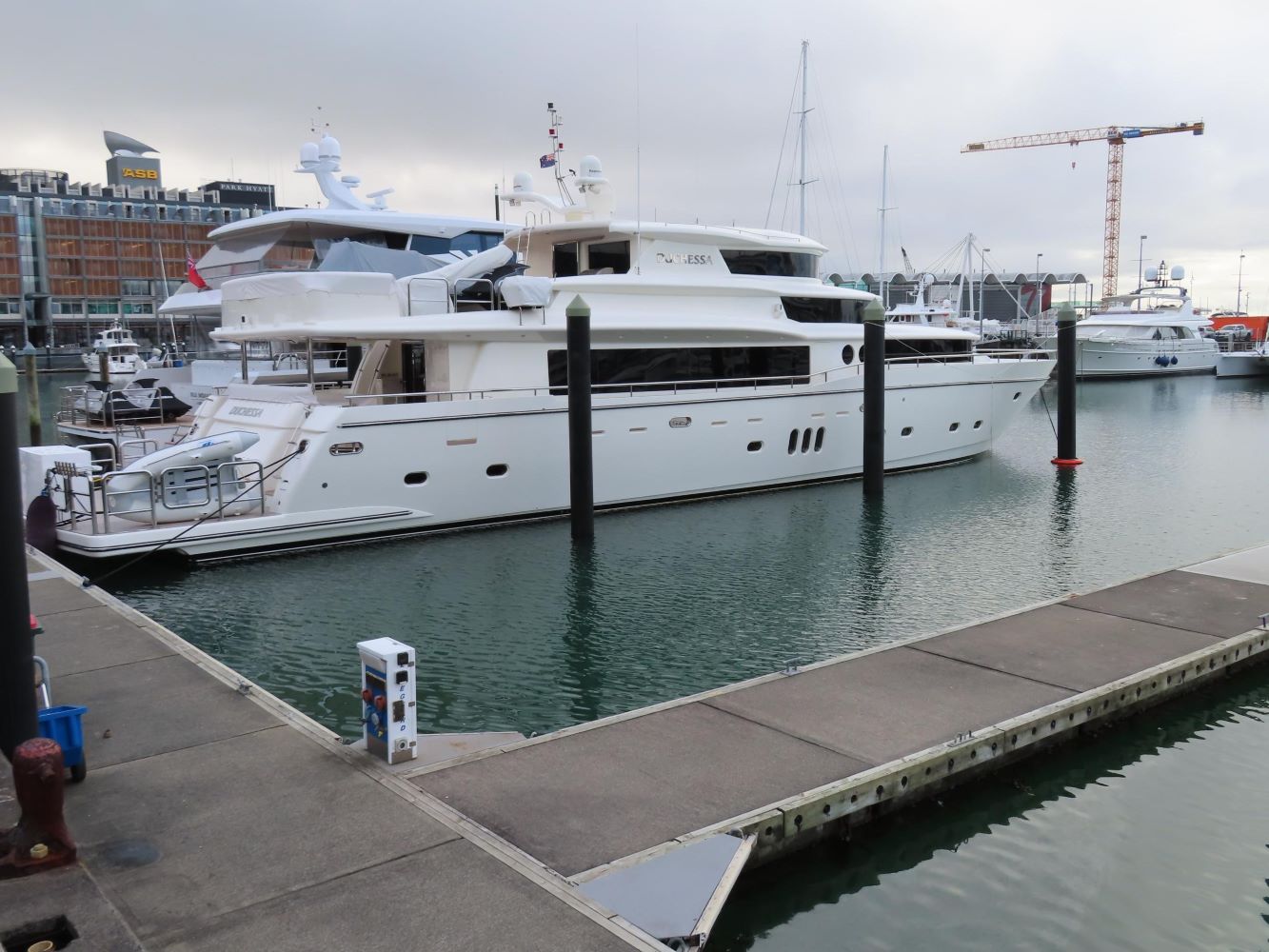 Duchessa
Duchessa
Duchessa: 29.6 metres in length and just two years old. Built by Permare, from San Remo, Italy. 10 guests in five cabins with five crew crammed into three cabins. With a maximum speed of 28 knots, and a fuel capacity of 10,000 litres propelling four (count ‘em) Volvo Penta IPS 1200 diesel engines, delivering a cruising speed of 24 knots.
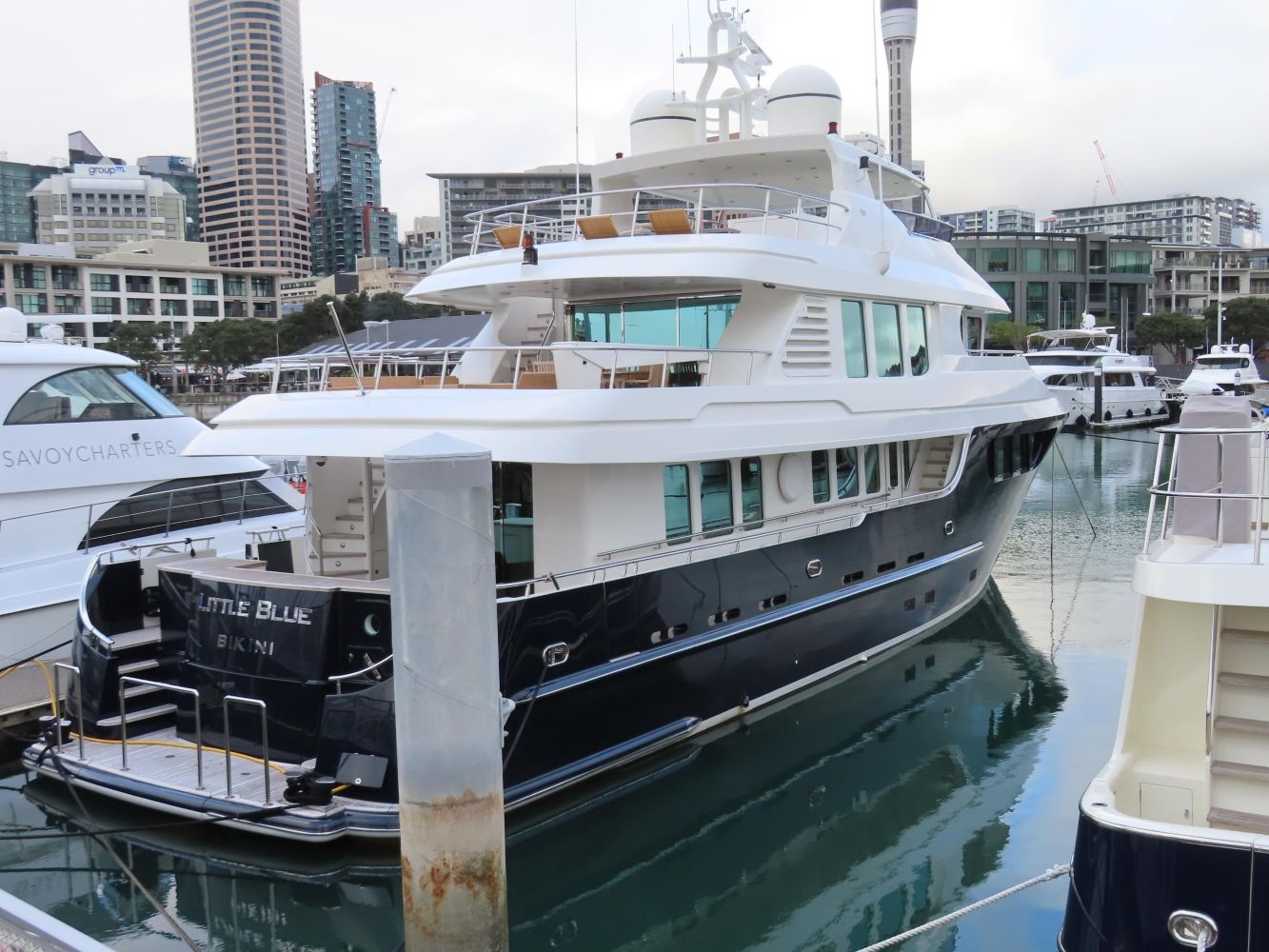 Little Blue
Little Blue
Little Blue: 27.7 metres, range of 3500 nautical miles, four guest cabins, built by Jade Yachts in Taiwan in 2007. Advertised for sale at $5.2 million on BoatInternational.com. Registered in Bikini, Marshall Islands.
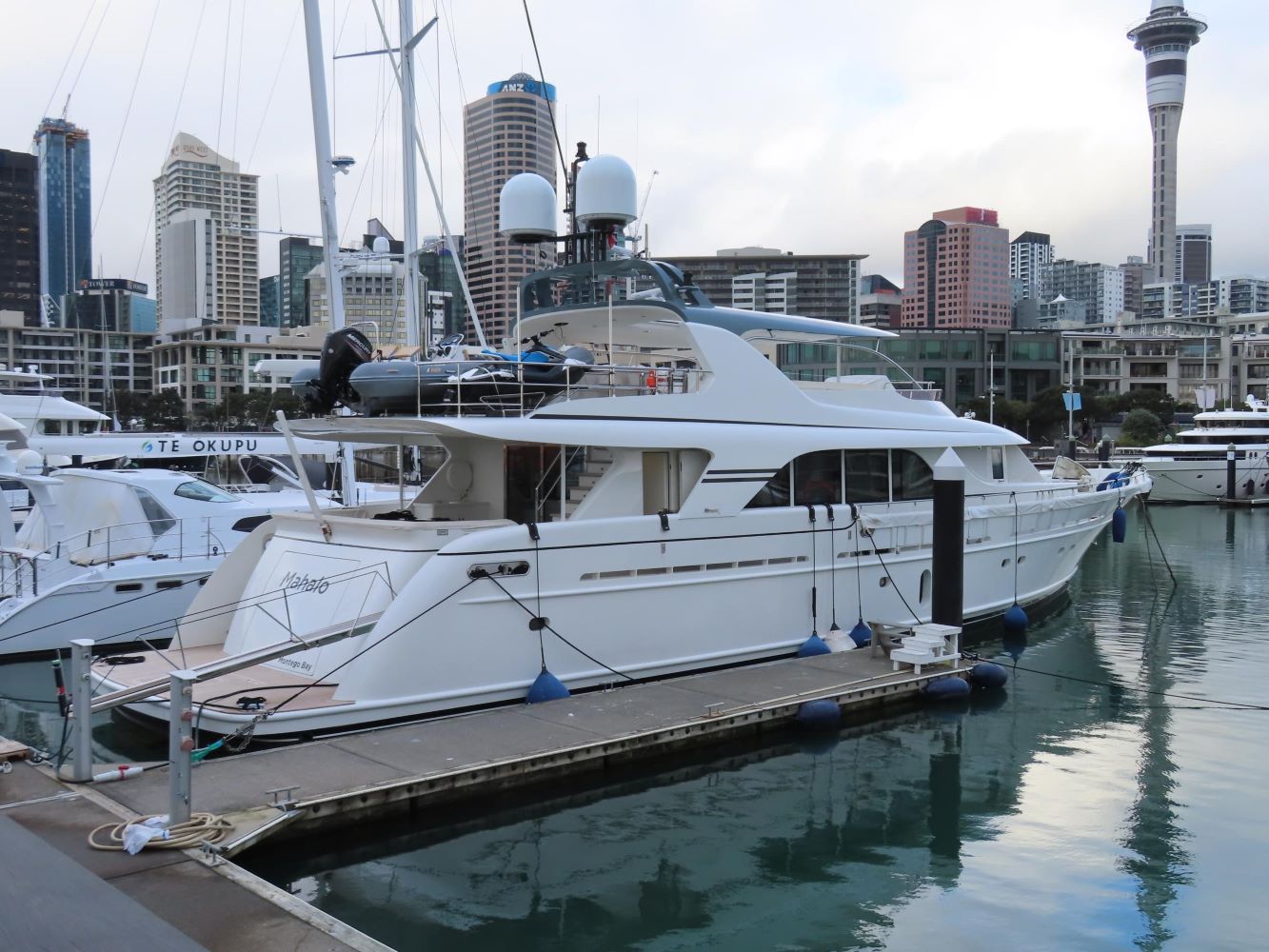 Mahalo
Mahalo
Mahalo: 30 metres. Built by Mulder shipyard in the Netherlands in 2014. Maximum speed 21 knots. Advertised for sale for $10.3 million at the 2016 Monaco Yacht Show, according to SuperYacht Times, and sold to an Australian the following year. Registered in Montego Bay, Jamaica.
Espiritu Santo: 30 metres, range of 4500 nautical miles (cruising at 10 knots, maximum speed 13 knots), eight guests. The first such luxury small ship built by OCEA Yachts, France, in 2002. First voyage was to Auckland for the 2003 America’s Cup. With a fuel capacity of 35,000 litres, filling the tank with diesel at current prices would clock in at roughly $44,000. Registered in New Caledonia.
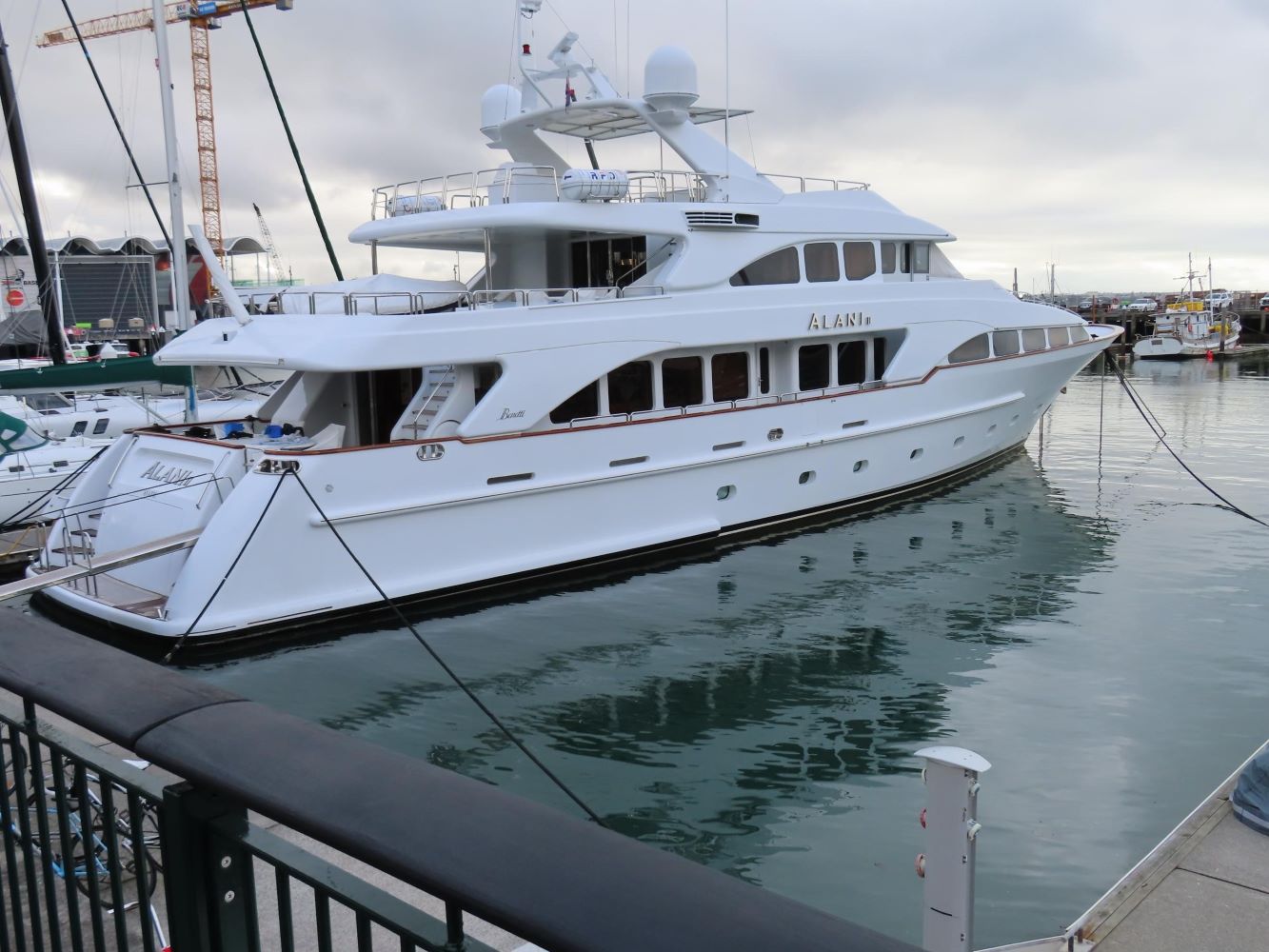 Alani II
Alani II
Alani II: 35 metres, built by Italian boatbuilders Benetti, in 2002. Had its most recent five-year refit at Oceania Marine, Whangarei, in late 2016. Accommodates up to 10 guests in five cabins, with six crew. Top speed of 16 knots and a range of 3800 nautical miles at a cruising speed of 15 knots. Originally registered in Kingstown, capital of the Caribbean island nation of St Vincent and the Grenadines, it now lists Avatiu in the Cook Islands as its home port.
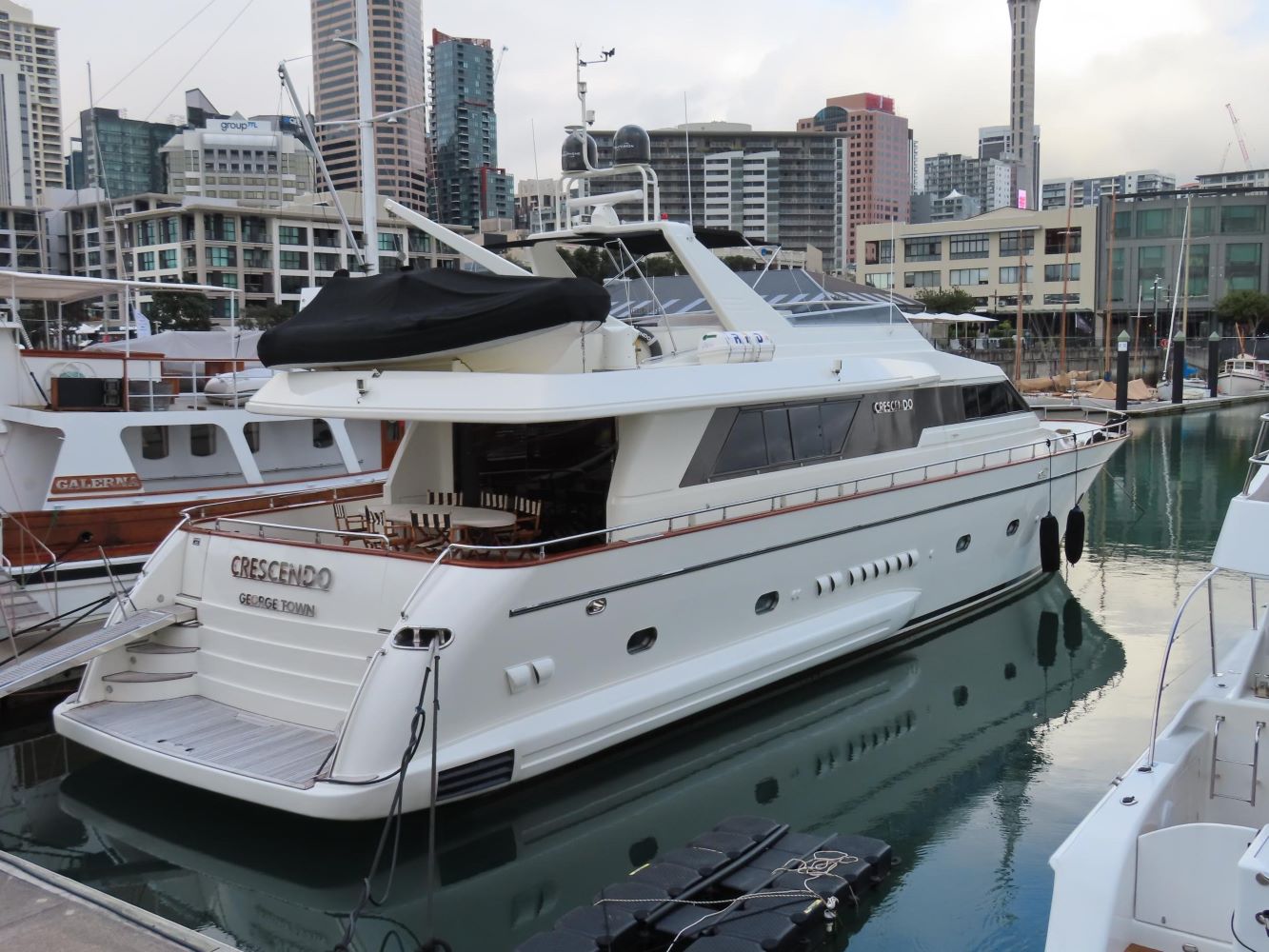 Crescendo
Crescendo
Crescendo: Cayman Islands-registered, but no other details available online. Definitely fairly large.
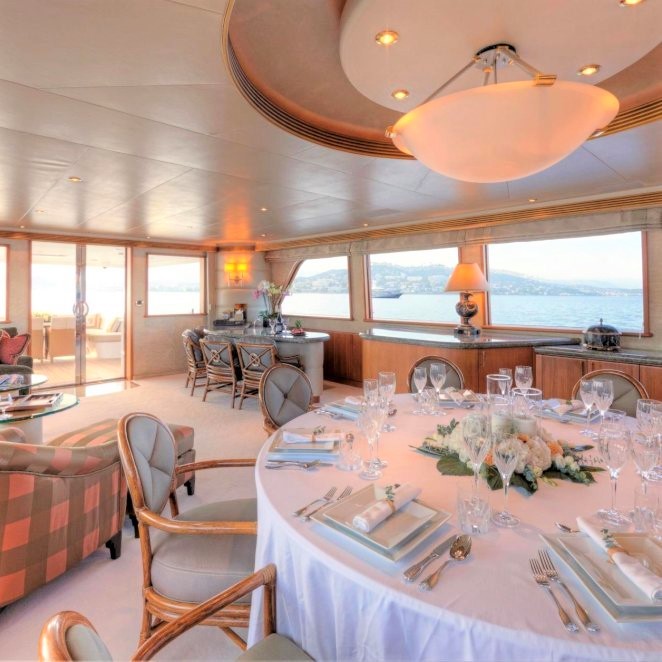 Integrity interior
Integrity interior
Integrity: 34 metres, built by Westport Yachts, Washington, USA. Registered in George Town, capital of the notorious tax haven the Cayman Islands. Sleeps eight guests and five crew, with a top speed of 24 knots and a 2500-nautical-mile range at 12 knots. Powered by two MTU (16V2000M90) 1850-horsepower (1380kW) diesel engines.
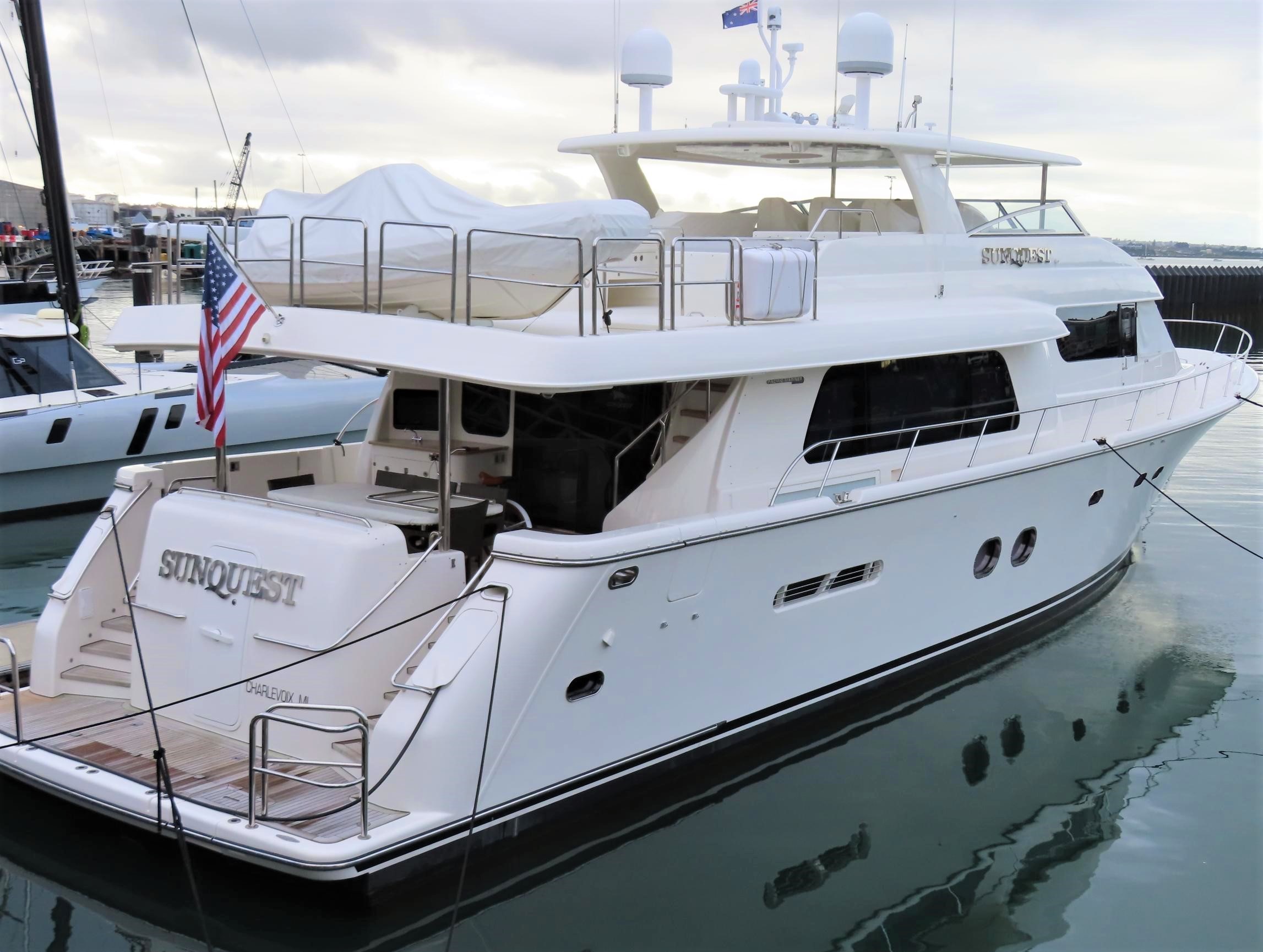 Sunquest
Sunquest
Sunquest: Built in 2011 and weighing in at 117 gross tons, Sunquest’s vital details are hidden behind ShipIndex.com’s impenetrable paywall, but the boat is intriguing for the fact that its home port is Charlevoix, a town on the northern reaches of freshwater Lake Michigan.
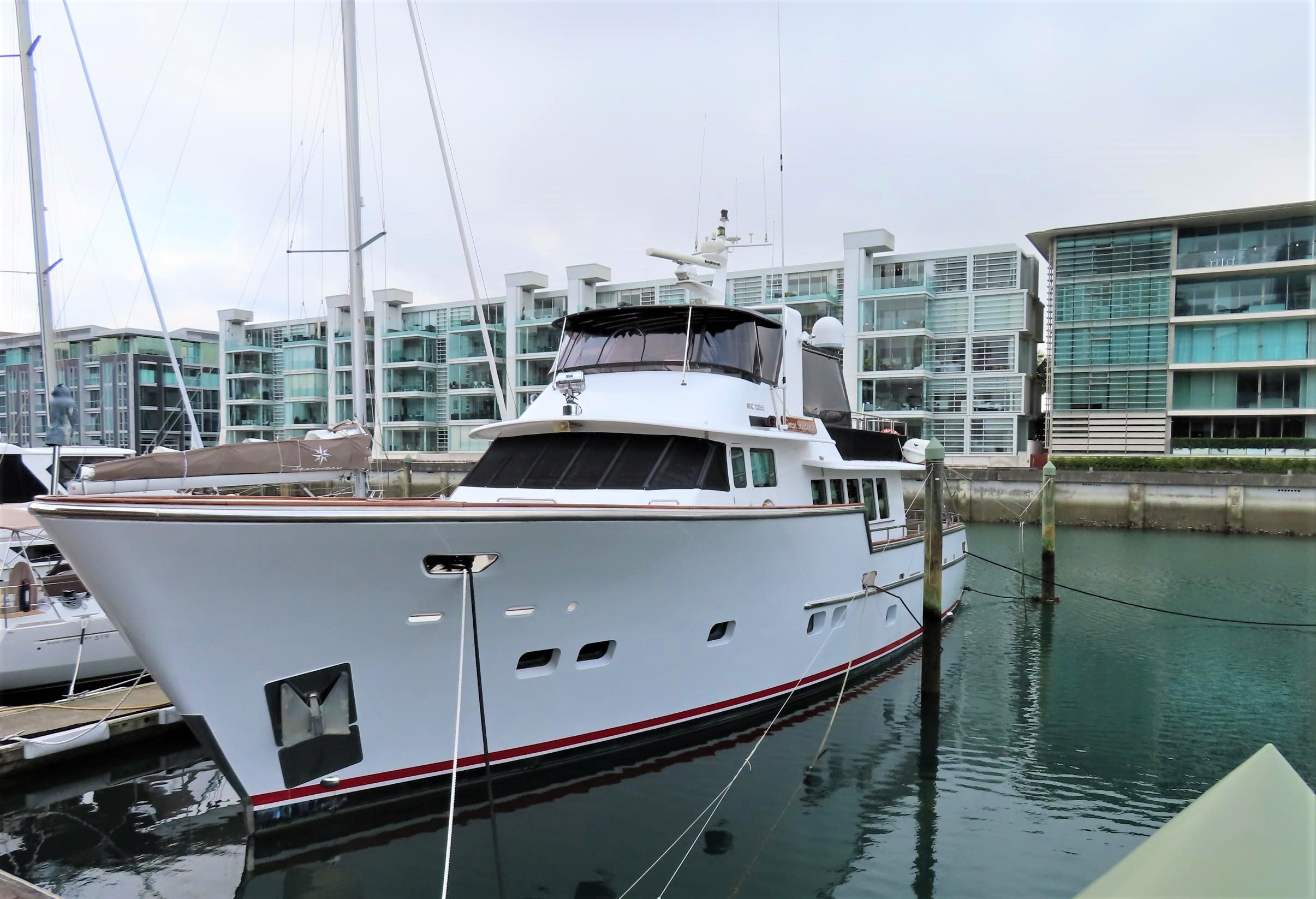 Oceanzpirit
Oceanzpirit
Oceanzpirit: Built in 2014 in California, this Nordhavn 60 design is listed for sale for $2.85 million. It was originally delivered to owners in Hong Kong before being moved to Fiji in 2015, and has cruised in the South Pacific over the last few years. The Nordhavn website, where the boat is listed, talks of “salon ottomans”, foldout teak tables, and carpets over cherrywood floors. At a mere 19 metres, NZ-registered Oceanzpirit is comparatively short compared to some of the other vessels moored at the Viaduct Harbour, and has a cruising speed of 8 knots.
Great Southern: 23 metres, with a range of more than 9000 nautical miles, Great Southern is in Auckland for charter during the America’s Cup, but can also be chartered from Stewart Island. Sleeps six and is yours for an overnight charter with just four people at $6400 plus GST, or a minimum of three hours for $900 plus GST. Cruising speed of 12 knots. NZ-registered.
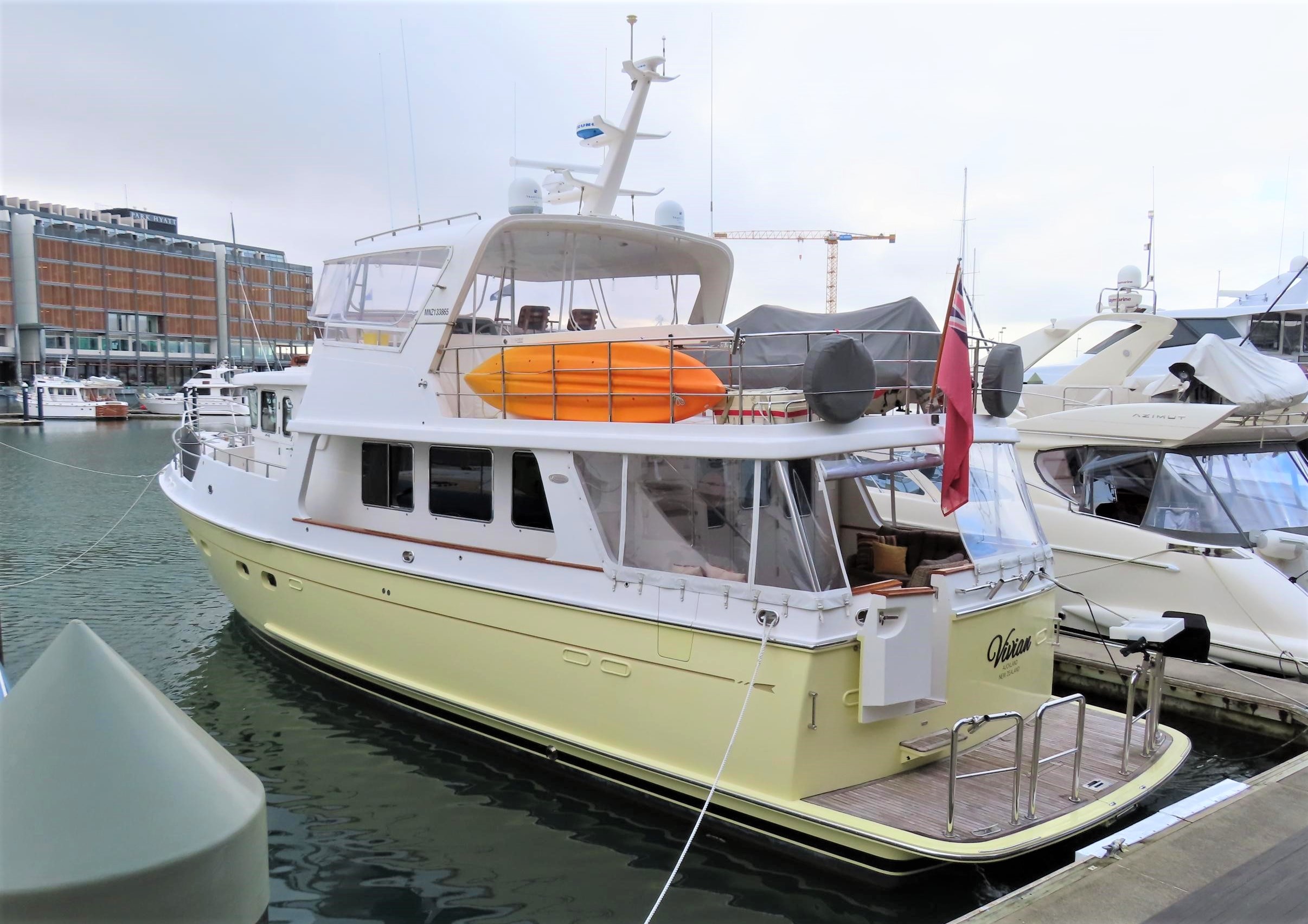 Vivian
Vivian
Vivian: 20m Selene build, sleeping six and with a couple of couches that would look at home in any modest NZer’s living room in the stern cockpit, Vivian is available for charter during The America’s Cup for $4800 + GST. Cruising speed of 8-9 knots. NZ-registered.
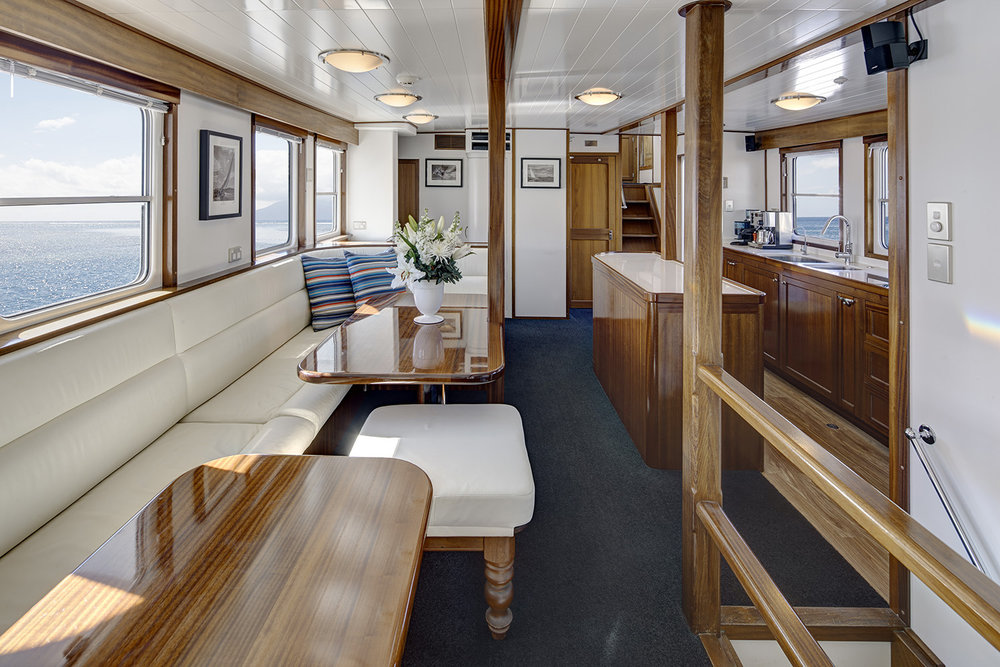 Awanui interior
Awanui interior
Awanui: 24 metres, cruising speed 10 knots. NZ-registered and recently refitted by Yachting Developments, in Auckland (interior pictured).
 Galerna
Galerna
Galerna: A grand traditional Scandinavian motor yacht for the renaissance sailor. Built in 1973 for the Danish royal family and known to have had Salvador Dali aboard at least briefly at some stage. Seven metres long, housing 10 guests, top speed of 11 knots and cruising speed of 8 knots. Charterworld.com lists Galerna as having spent time in Europe, the French West Indies, Micronesia, Phuket, Perth, the Seychelles, the US, and now Auckland. Built in Norway, Galerna is described as “extremely robust” with amenities that include “a fully equipped cocktail bar, excellent sound system and music selection, dance floor, area for live jazz”. There are no notes on where the jazz band might sleep, but there are four cabins and a crew of up to four.
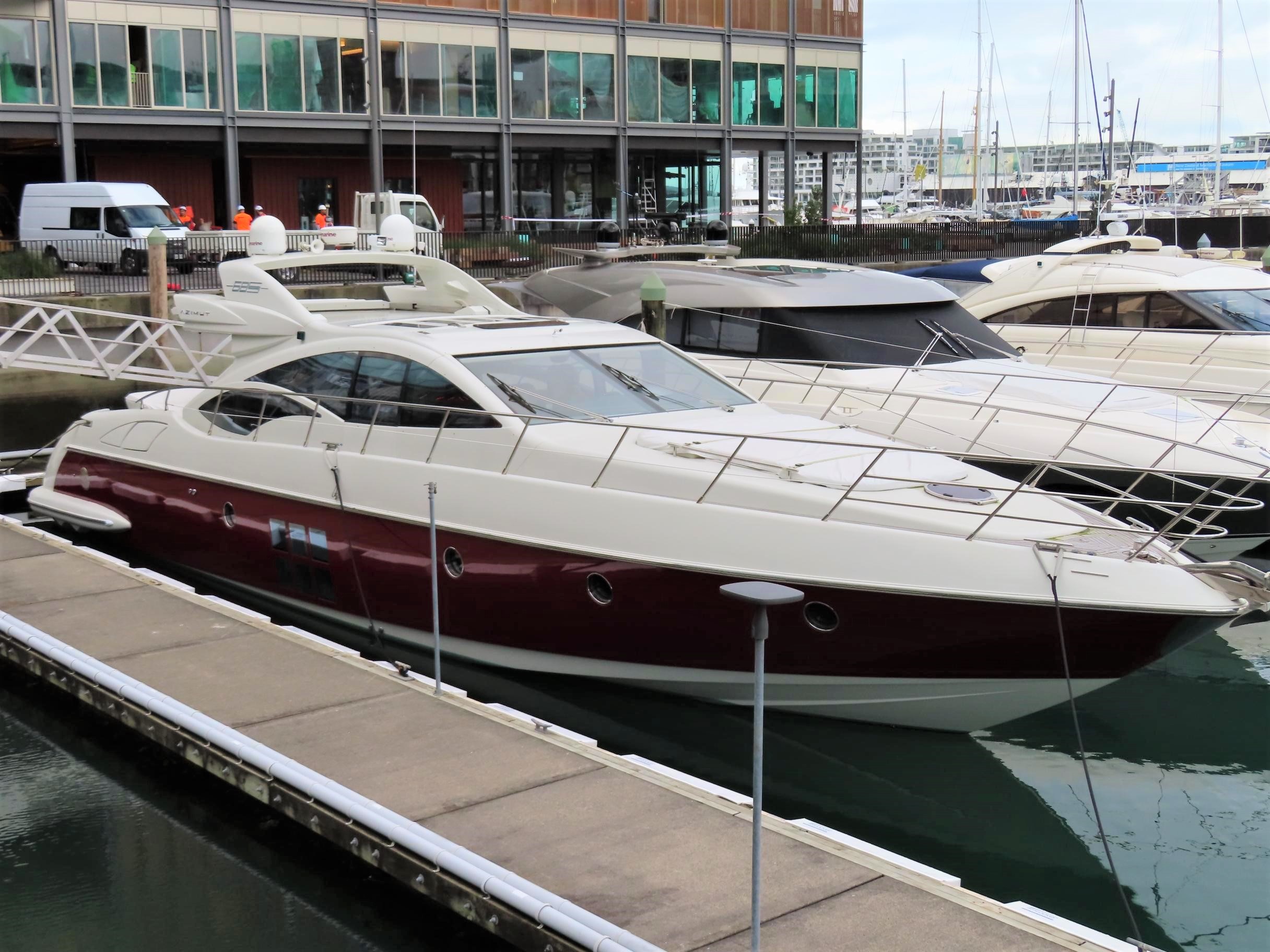 Azimut 60
Azimut 60
Azimut 60: Three of these 18.25-metre beasts are tied up together at the Viaduct Harbour. Not quite a launch, more a very large speedboat with accoutrements, there’s room for six guests and two crew in three cabins, and the top speed is 31 knots. Based in Italy, Azimut also owns Benetti, which has been building boats since 1873 and built Alani II (see above). Pinnacle Marine in Auckland will sell you a new Azimut for $3.1 million.
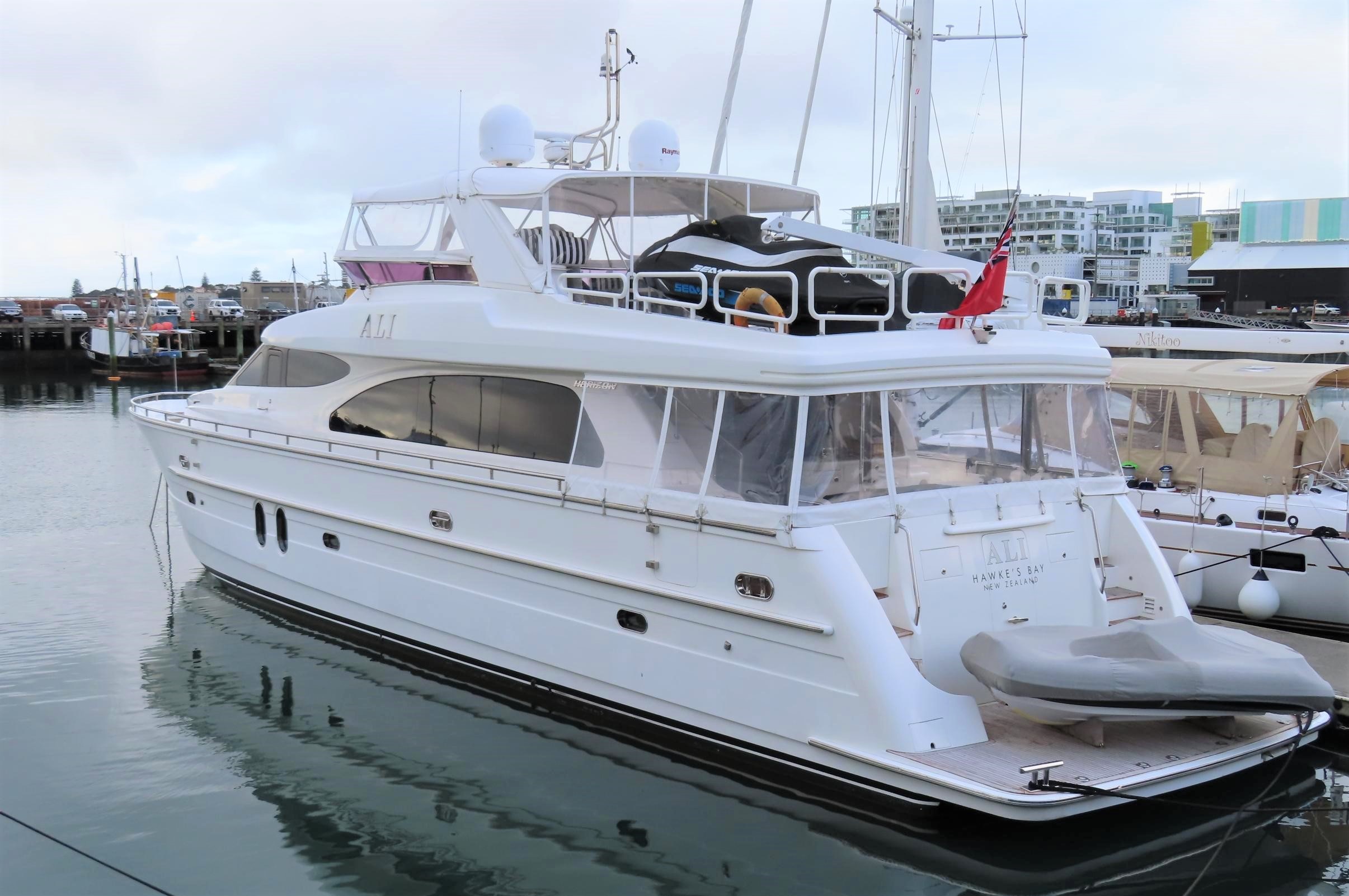 Ali
Ali
Ali: A fine-looking NZ-registered craft whose details are difficult to find. Based on its home port and its presence in downtown Auckland, it is perhaps best described as Metro magazine used to style unknown faces in its society pages: a visitor from Hawke’s Bay.
Peter Bale is a London-based NZ journalist who found himself in NZ during lockdown and refuses to leave. He reported the 1987 America's Cup in Fremantle for Reuters.
Additional reporting by Pattrick Smellie.


